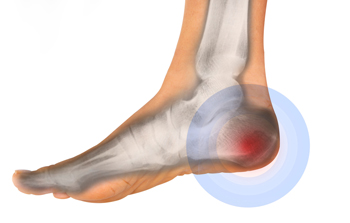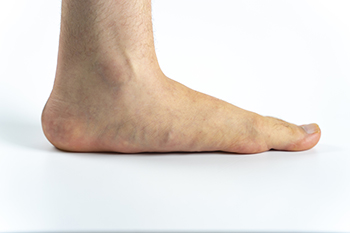NJ (908) 688-5577
NY (212) 737-2528

There are many people worldwide who have heel pain. It can happen for a variety of reasons, and prompt medical treatment may bring relief. A heel spur is known to be painful, and occurs as a result of calcium deposits that build up on the bottom of the heel. In severe cases, this is often removed surgically. Plantar fasciitis is a common heel injury and happens when the band of tissue that is on the sole of the foot becomes inflamed. This is known as the plantar fascia, and it connects the heel to the toes. Plantar fasciitis can happen from wearing shoes that do not have adequate support, and from standing on hard surfaces for most of the day. Heel pain may also happen from a foot injury, such as landing awkwardly on the heel. Relief may be felt when the affected foot is elevated, and this may relieve a portion of the swelling that can accompany heel pain. Many patients find it helpful to perform specific heel stretches, including standing on a step, and lowering one heel at a time until a gentle stretch is felt. Heel pain is effectively treated by a podiatrist, and it is strongly advised that you contact this type of doctor who can diagnose the cause, and offer you the correct treatment techniques.
Many people suffer from bouts of heel pain. For more information, contact Glenn Davison, DPM of Advanced Podiatry. Our doctor can provide the care you need to keep you pain-free and on your feet.
Causes of Heel Pain
Heel pain is often associated with plantar fasciitis. The plantar fascia is a band of tissues that extends along the bottom of the foot. A rip or tear in this ligament can cause inflammation of the tissue.
Achilles tendonitis is another cause of heel pain. Inflammation of the Achilles tendon will cause pain from fractures and muscle tearing. Lack of flexibility is also another symptom.
Heel spurs are another cause of pain. When the tissues of the plantar fascia undergo a great deal of stress, it can lead to ligament separation from the heel bone, causing heel spurs.
Why Might Heel Pain Occur?
Treatments
Heel pain should be treated as soon as possible for immediate results. Keeping your feet in a stress-free environment will help. If you suffer from Achilles tendonitis or plantar fasciitis, applying ice will reduce the swelling. Stretching before an exercise like running will help the muscles. Using all these tips will help make heel pain a condition of the past.
If you have any questions please contact our offices located in Union, NJ and New York . We offer the newest diagnostic and treatment technologies for all your foot and ankle needs.

Shoes are worn for foot protection and it is not necessary to have your children or babies wear them while indoors. However, they are urged to wear them when walking outside. The feet can become stronger because the toes can grip the floor when they are indoors, and this will aid in balancing. Outside terrain can be full of sharp objects and the feet can easily get hurt if they are not well protected. Your child’s first milestones can consist of walking and crawling, and these are often reached while indoors. These can be easier to accomplish when shoes are not worn, giving the feet more ability to move freely. If you would like additional information about the benefits of walking inside without shoes, please ask a podiatrist who can answer any questions you may have.
Making sure that your children maintain good foot health is very important as they grow. If you have any questions, contact Glenn Davison, DPM of Advanced Podiatry. Our doctor can provide the care you need to keep you pain-free and on your feet.
Keeping Children's Feet Healthy
Having healthy feet during childhood can help prevent medical problems later in life, namely in the back and legs. As children grow, their feet require different types of care. Here are some things to consider...
Although babies do not walk yet, it is still very important to take care of their feet.
Avoid putting tight shoes or socks on his or her feet.
Allow the baby to stretch and kick his or her feet to feel comfortable.
As a toddler, kids are now on the move and begin to develop differently. At this age, toddlers are getting a feel for walking, so don’t be alarmed if your toddler is unsteady or ‘walks funny’.
As your child gets older, it is important to teach them how to take care of their feet.
Show them proper hygiene to prevent infections such as fungus.
Be watchful for any pain or injury.
Have all injuries checked by a doctor as soon as possible.
Comfortable, protective shoes should always be worn, especially at play.
If you have any questions please feel free to contact our offices located in Union, NJ and New York . We offer the newest diagnostic and treatment technologies for all your foot and ankle needs.

Flat feet are common in babies and may extend through adulthood. In most cases, the arch fully develops during the teenage years and is visible while standing up. Adults who have flat feet may have inherited this condition or it may occur due to a foot injury. Flat feet may be uncomfortable for many patients and relief may be found when shoes that are worn have extra cushioning in the arch area. The arch provides support in addition to evenly distributing body weight to the legs and hips. There may be medical conditions that can contribute to getting flat feet. These include arthritis, cerebral palsy, and muscular dystrophy. Tendonitis, bunions, and plantar fasciitis may also develop from having flat feet and relief may be found when custom-made orthotics are worn. If you have flat feet, please consult a podiatrist who can determine the best course of treatment, which may include practicing specific foot-strengthening exercises.
Flatfoot is a condition many people suffer from. If you have flat feet, contact Glenn Davison, DPM from Advanced Podiatry. Our doctor will treat your foot and ankle needs.
What Are Flat Feet?
Flatfoot is a condition in which the arch of the foot is depressed and the sole of the foot is almost completely in contact with the ground. About 20-30% of the population generally has flat feet because their arches never formed during growth.
Conditions & Problems:
Having flat feet makes it difficult to run or walk because of the stress placed on the ankles.
Alignment – The general alignment of your legs can be disrupted, because the ankles move inward which can cause major discomfort.
Knees – If you have complications with your knees, flat feet can be a contributor to arthritis in that area.
Symptoms
Treatment
If you are experiencing pain and stress on the foot you may weaken the posterior tibial tendon, which runs around the inside of the ankle.
If you have any questions please feel free to contact our offices located in Union, NJ and New York . We offer the newest diagnostic and treatment technologies for all your foot and ankle needs.

Many beginning runners make mistakes that can cause injuries. Here are a few tips to prevent that from happening. Start with getting running shoes that are right for your feet, which includes evaluating your running style and foot type. It is recommended to replace shoes after about 350 miles, and to alternate with an extra pair when you are halfway through the lifespan of your first pair of shoes. Second, try to avoid doing too much, too soon. Experts agree that the easiest way to get injured is by running too far, for too long, too fast, and too often. It is advised to increase mileage by a maximum of 10 percent a week. It is also recommended to combine walking and running, at first, as well as taking at least one day off between runs. One of the most common causes of injury in beginners is overstriding, which consists of landing heel first with your foot ahead of the body’s center of gravity. Instead, try landing midsole, with the body’s weight directly over the foot. If you need further guidance about gait and foot type, or are having problems with your feet and ankles after running, please consult with a podiatrist.
All runners should take extra precaution when trying to avoid injury. If you have any concerns about your feet, contact Glenn Davison, DPM of Advanced Podiatry. Our doctor will treat your foot and ankle needs.
How to Prevent Running Injuries
There are a lot of mistakes a runner can make prior to a workout that can induce injury. A lot of athletes tend to overstretch before running, instead of saving those workouts for a post-run routine. Deep lunges and hand-to-toe hamstring pulls should be performed after a workout instead of during a warmup. Another common mistake is jumping into an intense routine before your body is physically prepared for it. You should try to ease your way into long-distance running instead of forcing yourself to rush into it.
More Tips for Preventing Injury
If you have any questions, please feel free to contact our offices located in Union, NJ and New York . We offer the newest diagnostic and treatment technologies for all your foot care needs.